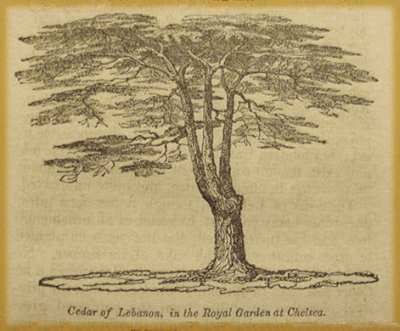
Timber: Cedar
The CEDAR OF LEBANON (Pinus cedrix) would, if the rapidity of its growth corresponded with its other properties, be the most valuable tree in the forest. Its resistance to wear is not equal to that of the oak, but it is so bitter that no insect will touch it, and it seems to be proof against time itself. We are told that the timber in the temple of Apollo at Utica was found undecayed after a lapse of two thousand years, and that a beam in the temple of Diana, at Saguntun (Morvedro) was fetched from Zante, two centuries before the Trojan war.
Some of the most celebrated erections of antiquity were constructed of this tree.
"Solomon raised a levy of thirty thousand men out of all israel; and he sent them to Lebanon, ten thousand a month .... fourscore hewers in the mountains ....and he covered the temple with beams and boards of cedar. And he built chambers against it, which rested on the house, with timber of cedar. The cedar within was carved with knops and flowers; all was cedar; there was no stone seen".
Ancient writers mention that the ships of Sesostris, the Egyptian conqueror, one of them two hundred and eighty cubits long, were formed of cedar, as was the gigantic statue of Diana at Ephesus.
There are other trees called cedars which, although resembling them, do not belong to the pine family at all. White cedar, for example, which is a cypress, and red cedar, which is a juniper.
In addition to the durability of its timber, the cedar is, in its appearance, the most majestic of trees. When it stands alone in a worthy situation, it is hardly possible to conceive of a finer ornament.
Its height in this country has seldom equalled the taller of the larches. The description of the cedar of Lebanon by the prophet Ezekiel is fine and true:
.....a cedar in Lebanon, with fair branches, and of an high stuture; and his top was among the thick boughs. His boughs were multiplied, and his branches became long. The fir trees were not like his boughs, nor the chesnut trees like his branches; nor any tree in the garden of God like unto him in beauty".
Modern travellers to Lebanon say that very few now exist.
The cedar of Lebanon has not been planted much as a timber tree. It is more difficult to rear, and needs a richer soil than the pine and the larch. The main objection appears to be the slowness of its growth, though it is not much slower than the oak. Some cedars in good soil, e.g. at Highclere, have grown very quickly. The ones in the royal garden at Chelsea also grew quickly; the circumference of one of them 2ft from the ground after 83 years was twelve feet.
Woodcut:

Cedar in the Royal Garden at Chelsea.
summarised from "The Library of Entertaining Knowledge - Timber trees" (1829), pub. Charles Knight, Pall Mall.
ND, habitat21
big turbines
small turbines